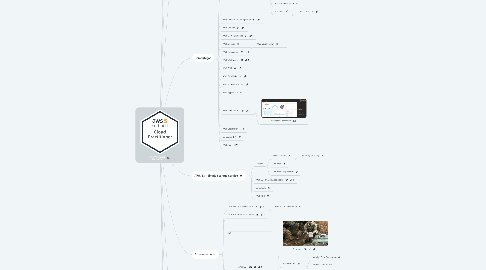
1. Visão
1.1. Capex X Opex
1.1.1. OPEX
1.1.2. CAPEX
1.2. Modelos de Computação
1.2.1. On-Premises
1.2.2. IaaS
1.2.3. Paas
1.2.4. Saas
1.3. Vantagens
1.3.1. Save Money
1.3.2. Stop Guessing
1.3.3. Go Goal in minutes
1.3.4. Economic of Scale
1.3.5. Increase Speed and agility
1.4. Conceitos de tecnologia em Nuvem
1.4.1. Elasticidade
1.4.2. Scalability
1.4.2.1. Horizontal
1.4.2.2. Vertical
1.4.3. Alta disponibilidade
1.5. Computação Serveless
1.5.1. Conceito
1.6. Acceptable use policy
2. Infra Estrutura
2.1. Environments
2.1.1. Region
2.1.1.1. AWS GovCloud
2.1.2. Edge Locations
2.1.3. Availability Zones
2.2. Shared Responsability
2.2.1. AWS - OFF cloud
2.2.2. Customer - IN Cloud
2.3. Health Check
2.3.1. AWS Service Health dashboard
2.3.2. Personal Health dashboard
3. Contas e Custos
3.1. Contas
3.1.1. Planos
3.1.1.1. Basic
3.1.1.2. Developer
3.1.1.3. Business
3.1.1.4. Enterprise
3.1.2. Suporte
3.1.2.1. AWS TAM - Techinical account manager
3.1.2.2. AWS Professional Services
3.1.2.3. AWS Concierge
3.1.2.4. AWS Partner Network
3.1.2.5. APN Consulting Partners
3.2. Custos
3.2.1. AWS Budget
3.2.2. AWS Simple Calculator
3.2.2.1. AWS Simple Monthly Calculator
3.2.3. AWS Cost Explorer
3.2.4. AWS TCO Calculator
3.2.5. AWS Pricing Calculator
3.2.5.1. Billing & Cost Management
3.2.6. AWS Consolidated Billing
3.2.7. AWS Organizations
3.2.7.1. Features
3.2.7.1.1. Centralized management
3.2.7.1.2. Consolidated billing
3.2.7.1.3. Hierarchical grouping
3.2.7.1.4. Account Access Control
3.2.7.1.5. Standardizing Tags
3.2.7.1.6. Integration with IAM
3.3. Documentação
3.4. Formas de Acesso
3.4.1. AWS Console Management
3.4.2. AWS CLI - Command Line Interface
3.4.3. AWS SDK - Software development Kit
4. Segurança
4.1. AWS IAM
4.1.1. Users
4.1.2. Groups
4.1.3. Functions
4.1.4. Politicas e Permissões
4.2. Tipos
4.2.1. AWS MFA
4.2.2. AWS ACCESS KEYS
4.2.3. AWS KEY PAIRS
4.3. Serviços
4.3.1. AWS KMS
4.3.2. AWS Shield
4.3.3. AWS CLOUDHSM
4.3.4. AWS WAF
4.3.5. AWS Cognito
4.3.6. AWS GuardDuty
4.3.7. Amazon Inspector
4.3.8. Amazon Detective
4.3.9. Amazon Security Hub
5. Computação
5.1. AWS EC2 - Elastic Compute Cloud
5.1.1. Planos
5.1.1.1. On demand
5.1.1.2. Dedicated hosts
5.1.1.3. Spot Stances
5.1.1.4. Reserved instances
5.1.2. AWS Instances Store
5.1.3. AWS AMI
5.1.3.1. Golden AMI
5.2. AWS ASG - Auto Scaling Group
5.3. AWS Lambda
5.4. AWS Elastic BeanStalk
5.5. AWS Lightsail
5.5.1. AWS Step Function
5.6. AWS Rekognition
5.7. AWS Workspaces
5.8. AWS EMR
5.9. AWS OPSWorks
5.10. AWS Market Place
5.11. AWS HyperVisor
5.12. AWS QUICKSIGHT
5.12.1. Exemplo de dashboard
5.13. AWS SageMaker
5.14. S3 Standard-IA
5.15. AWS SWF
6. AWS S3 - Simple Storage Service
6.1. Classes
6.1.1. S3 One Zone-IA
6.1.1.1. S3 Inteligent Tiering
6.1.2. S3 Glacier
6.1.3. S3 Glacier Deep Archive
6.2. AWS S3 - Transfer Acceleration
6.3. S3 Outputs
6.4. AWS CRR
7. Armazenamento
7.1. AWS EBS - ElasticBlockStore
7.1.1. AWS EC2 - Stance Store
7.2. AWS EFS - Elastic File System
7.3. AWS Snow
7.3.1. Snowcone
7.3.2. SnowBall
7.3.2.1. Snowball Edge Computing
7.3.2.2. Snowball Data Transfer
7.3.2.3. Snowball Edge Storage
7.3.3. SnowMobile
7.4. AWS Storage GateWay
7.5. AWS ElasticSearch
7.6. AWS Kinesis
8. Redes
8.1. VPC
8.1.1. NAT Gateway
8.1.2. Security Group
8.1.3. Tabela de Roteamento
8.1.4. Internet Gateway
8.1.5. Sub-Rede Privada
8.1.6. Sub Rede Pública
8.1.7. Network ACL
8.2. ELB - Elastic Load Balancing
8.2.1. Aplication Load Balancer
8.2.2. Network Load Balancer
8.2.3. Gateway Load Balancer
8.3. Route 53
8.3.1. Routing Policies
8.3.1.1. Simple routing
8.3.1.2. Failover routing
8.3.1.3. Geolocation routing
8.3.1.4. Geoproximity routing
8.3.1.5. Latency routing
8.3.1.6. Multivalue answer routing
8.3.1.7. Wighted routing
8.3.2. Principais funções (gerenciamento de DNS)
8.3.2.1. Register domain names
8.3.2.2. Route internet traffic to the resources for your domain
8.3.2.3. Check the health of your resources
8.4. CloudFront
8.5. Direct Connect
8.6. Elastic IP
9. Banco de dados
9.1. RDS - Relational Database Service
9.1.1. Aurora
9.1.2. MySQL
9.1.3. SQLServer
9.1.4. MariaDB
9.1.5. PostgeSQL
9.1.6. Backup- point in time recovery
9.2. DynamoDB
9.3. OracleDB
9.4. AWS ElastiCache
9.5. RedShift
9.6. NEPTUNE
9.6.1. Exemplo de Grafo
9.7. Athena
9.8. AWS Glue
9.9. EMR
9.10. Database Migration Service
10. Gerenciamento
10.1. AWS CloudWatch
10.2. AWS CloudTrail
10.3. AWS CloudFormation
10.3.1. Otimização de custo
10.4. AWS Trusted Adivisor
10.4.1. Cost Optimization
10.4.2. Performance
10.4.3. Security
10.4.4. Fault Tolerance
10.4.5. Service Limits
10.5. Framework Well-Architected
10.5.1. Excelência Operacional
10.5.2. Segurança
10.5.3. Confiabilidade
10.5.4. Otimização de Custos
10.5.5. Eficiência de Performance
